The Process Of Progression Chords On Contemporary Music Of Thai Traditional Music “BANG BAI”
Keywords:
The Process of Progression Chords, Contemporary music styles, Bang BaiAbstract
A traditional Thai melody named Pleng Bangbai in speed “song chun” version aninomous composer. The rhythm of this song consists of 2 movements to accompany of vocal (voice melody) masked play or Thai opera (La Korn). Bangbai have been composed into 3 version, called Pleng Bangbai Tao in speed (tempo) Samchun, Songchun and Chundio.
The purpose of this academie artticle in to rearrange Thai music, especially to use The Western Harmony chord progression, Which is usually the piano, Guitar or Band employed do play and accompany the main melody to play with any melodie instruments, much as the thai music styles, for example, Looktung, Lookkrung, with chord progression of II V I along each melodie phrases, but the author will keep the original and Thai impression and Thai style on the solo instruments with the same ornaments and variation, etc. suitable to western music chord progression, to be a new creating aesthetic interchanged of Thai and western music, to be accepted by the present audience, to appreciate both Thai and Western music in crossing music cultures by using harmony of western music to give more colours with the new chord progression to replace the basic chord progression of Theory, but with appreciation of all.
References
โกวิทย์ ขันธศิริ และคณะ. (2529) การวิเคราะห์เพลงไทยด้วยคอมพิวเตอร์. กรุงเทพมหานคร : จุฬาลงกรณ์มหาวิทยาลัย
จิรภัทร อังศุมาลี. (2552). Jazz-Rock Fusion แจ๊สวิถี (ขบวนการ 2). กรุงเทพฯ: มติชน.
ณรงค์ฤทธิ์ ธรรมบุตร. (2552). การประพันธ์เพลงร่วมสมัย. กรุงเทพมหานคร:สำนักพิมพ์แห่งจุฬาลงกรณ์ มหาวิทยาลัย.
ณรงค์ชัย ปิฎกรัชต์. (2557). สารานุกรมเพลงไทย. นครปฐม:สำนักพิมพ์มหาวิทยาลัยมหิดล.
บรรจง ชลวิโรจน์. (2545). การประสานเสียง.(พิมพ์ครั้งที่ 2). กรุงเทพฯ: เสมาธรรม.
ศักดิ์ศรี วงศ์ธราดล. (2555ก). ทฤษฎีดนตรีแจ๊สเล่ม 1. กรุงเทพฯ: วงศ์สว่างพับลิชชิ่ง แอนด์ พริ้นติ้ง.
ศักดิ์ศรี วงศ์ธราดล. (2558). ทฤษฎีดนตรีแจ๊สเล่ม 2. กรุงเทพฯ: คณะดุริยางคศาสตร์ มหาวิทยาลัยศิลปากร.
ศิลปบรรเลง และลิขิต จินดาวัฒน์. (2521) ดนตรีไทยศึกษา. กรุงเทพมหานคร :สำนักพิมพ์อักษรเจริญทัศน์
Thummabutr, N. (2009). Kanprapun pleng reum sa mai [Contemporary music composition]. Bangkok: Chulalongkorn University.
Pidokrat, N. (2014). Sa ra nu krom pleng thai [The Encyclopedia of Thai song]. NakhonPathom: Mahidol University.
Chonwirot, B. (2002). Kan prasan siang (Phim khrang thi 2) [Harmony (2nd ed.)]. Bangkok: Sema tham.
Wongtharadol, S. (2015). Thritsadi dontree jazz lem 2 [Theory of Jazz Music Volume 2]. Bangkok: Faculty of Music Silpakorn University.
Aebersold, J. (1967). How to Play Jazz and Improvise. 6thed. New Albany: Jamey Aebersold.
Alldis, D. (2003). A Classical Approach to Jazz Piano Improvisation. Milwaukee: Hal Leonard.
Berg, S. (1998). Essentials of Jazz Theory. Milwaukee: Hal Leonard.
Berkman, D. (2013). The Jazz Harmony Book. Petaluma: Sher Music.
Levine, M. (1995). The Jazz Theory Book. U.S.A.: Sher Music.
Ligon, B. (2001). Jazz Theory Resources. Milwaukee: Hal Leonard.
Mock, D. (2001). Artful Arppeggios. Milwaukee: Hal Leonard.
Nettles, B. (1987). Music Harmony 1. Boston: Berklee College of Music.
Ricker, R. (1976). Pentatonic Scales for Jazz Improvisation. Van Nuys: Alfred Music.
Sokolow, F. (1998). Musicians Institute Essential Concepts. Milwaukee: Hal Leonard.
Wyatt, K. & Schroeder, C. (1998). Musicians Institute Essential Concepts Harmony & Theory. Milwaukee: Hal Leonard.
Downloads
Published
Issue
Section
License
Copyright (c) 2022 Pacific Institute of Management Science

This work is licensed under a Creative Commons Attribution-NonCommercial-NoDerivatives 4.0 International License.
บทความที่ได้รับการตีพิมพ์เป็นลิขสิทธิ์ของ สถาบันวิทยาการจัดการแห่งแปซิฟิค
ข้อความที่ปรากฏในบทความแต่ละเรื่องในวารสารวิชาการเล่มนี้เป็นความคิดเห็นส่วนตัวของผู้เขียนแต่ละท่านไม่เกี่ยวข้องกับสถาบันวิทยาการจัดการแห่งแปซิฟิค และคณาจารย์ท่านอื่นๆในสถาบันฯ แต่อย่างใด ความรับผิดชอบองค์ประกอบทั้งหมดของบทความแต่ละเรื่องเป็นของผู้เขียนแต่ละท่าน หากมีความผิดพลาดใดๆ ผู้เขียนแต่ละท่านจะรับผิดชอบบทความของตนเองแต่ผู้เดียว







